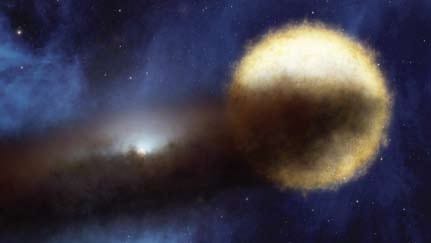
Artist’s impression of ε Aurigae. Credit: NASA/JPL–Caltech
By James Dacey
Citizen science projects sound great in principle, but I often wonder just how much Joe Bloggs (or Joe Schmoe) can really contribute to scientific understanding, and whether we can really help the professionals without selling our homes to fund all the specialist gear.
Well, here’s a project where we apparently can.
Citizen Sky launched last year by the American Association of Variable Star Observers to help solve a mystery that has puzzled astronomers for the past 175 years.
The mission is for the public to help the professionals to work out what’s going on with a rare star system known as epsilon Aurigae, which could hold important clues about stellar structure and how stars evolve. Epsilon Aurigae is visible with the naked eye even in the most light-polluted of cities, so you don’t even need a telescope, say the organizers.
Let me give you the back story.
Stars don’t like to be alone and an estimated 60% of stars can be found in either binary or multiple star systems. However, from our vantage point here on Earth, only 0.2% of these systems are eclipsing – that is, a star darkens from our point of view when a second star or other astronomical body sweeps across our line of vision. These eclipses are very useful because they allow astronomers to determine many things about the star such as its temperature, luminosity and even the presence of distant planets.
But epsilon Aurigae is rarer still because since its discovery in 1821 astronomers have never been quite sure what is doing the eclipsing. Eclipses in this system occur roughly once every 27 years and last for the unusually long time of two years. This suggests that the eclipsing object is larger than the stars themselves, and one of the stars is permanently hidden over a range of wavelengths.
The latest eclipse of epsilon Aurigae began last August and a paper released yesterday in Nature reports the first direct images of the eclipse and the researchers suggest it is caused by a large dust cloud passing in front of the binary system. However, there are still many questions regarding the properties and form of this dust cloud – and this is where the citizen science comes in.
This July and August will see the middle of the eclipse and this is the best time to pin down the properties of the dust cloud, which the researchers believe is the remnants of an accretion disc. Astronomers want all the observations they can get, including information from keen amateurs. “With a good pair of eyes and a finder chart – which we will give you – you can monitor this eclipse,” says Rebecca Turner, the Citizen Sky project manager.
You can hear more about the kind of data they are looking for on the project website.



